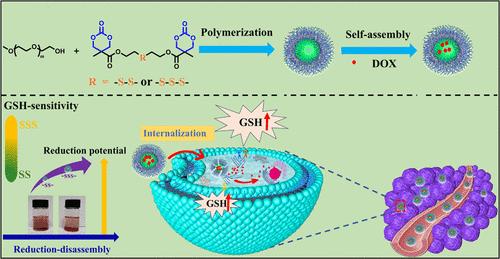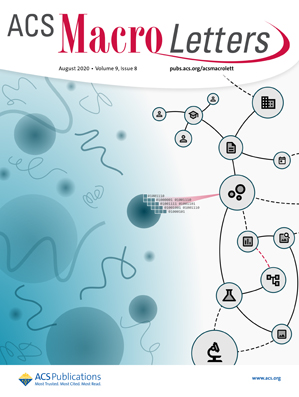Preparation of Disulfide/Trisulfide Core-Cross-Linked Polycarbonate Nanocarriers for Intracellular Reduction-Triggered Drug Release
IF 5.1
Q1 POLYMER SCIENCE
引用次数: 0
Abstract
Polymeric nanocarriers have attracted significant attention in the field of anticancer drug delivery due to their unique advantages. However, designing nanocarriers that can maintain stability in the bloodstream while achieving specific drug release within tumor cells remains a major challenge. To address this issue, constructing reversible cross-linked polymeric nanocarriers that are sensitive to the intracellular reducible glutathione (GSH) characteristic of the tumor microenvironment is a promising strategy. Based on this, we designed and synthesized two novel six-membered bicyclic carbonate monomers containing disulfide (DSBC) and trisulfide (TSBC) bonds. Through a one-step ring-opening polymerization, a series of reduction-sensitive polycarbonate copolymers (i.e., PEG–PDSBC and PEG–PTSBC) were prepared, and doxorubicin (DOX)-loaded nanoparticles were fabricated using a nanoprecipitation method. The in vitro drug release behaviors of these nanoparticles were systematically investigated. The results showed that these polymers, due to the cross-linked structure formed by the ring-opening polymerization of their bicyclic monomers, could self-assemble into stable nanoparticles. Under different concentrations of glutathione, DOX-loaded PEG–PTSBC nanoparticles demonstrated faster drug release, indicating more optimized intracellular drug release properties. Further cytotoxicity experiments revealed that both types of blank nanoparticles exhibited good biocompatibility with the 4T1 and NIH-3T3 cells. Fluorescence microscopy and flow cytometry results further indicated that DOX-loaded PEG–PTSBC nanoparticles released more drugs in 4T1 cells, significantly inhibiting tumor cell growth compared with DOX-loaded PEG–PDSBC nanoparticles, with no noticeable difference in NIH-3T3 normal cells. In conclusion, this study suggests that trisulfide cross-linked polycarbonate-based nanocarriers hold promise as an anticancer drug delivery system that combines stability in the bloodstream with specific intracellular drug release, offering new insights for the development of novel, efficient, and safe anticancer nanomedicines.

制备二硫/三硫核心交联聚碳酸酯纳米载体,用于细胞内还原触发的药物释放
聚合物纳米载体因其独特的优势在抗癌药物输送领域备受关注。然而,设计既能在血液中保持稳定,又能在肿瘤细胞内实现特异性药物释放的纳米载体仍是一大挑战。为了解决这个问题,构建对肿瘤微环境中细胞内还原性谷胱甘肽(GSH)特征敏感的可逆交联聚合物纳米载体是一种很有前景的策略。在此基础上,我们设计并合成了含有二硫键(DSBC)和三硫键(TSBC)的两种新型六元双环碳酸酯单体。通过一步开环聚合,制备了一系列还原敏感性聚碳酸酯共聚物(即 PEG-PDSBC 和 PEG-PTSBC),并采用纳米沉淀法制备了负载多柔比星(DOX)的纳米颗粒。系统研究了这些纳米颗粒的体外药物释放行为。结果表明,由于双环单体开环聚合形成的交联结构,这些聚合物可以自组装成稳定的纳米颗粒。在不同浓度的谷胱甘肽作用下,负载 DOX 的 PEG-PTSBC 纳米颗粒的药物释放速度更快,表明其细胞内药物释放性能更加优化。进一步的细胞毒性实验表明,这两种空白纳米粒子与 4T1 和 NIH-3T3 细胞都具有良好的生物相容性。荧光显微镜和流式细胞术结果进一步表明,与负载 DOX 的 PEG-PDSBC 纳米颗粒相比,负载 DOX 的 PEG-PTSBC 纳米颗粒在 4T1 细胞中释放的药物更多,能显著抑制肿瘤细胞的生长,而在 NIH-3T3 正常细胞中则无明显差异。总之,这项研究表明,三硫化物交联聚碳酸酯纳米载体有望成为一种抗癌药物递送系统,它兼具在血液中的稳定性和细胞内药物释放的特异性,为开发新型、高效、安全的抗癌纳米药物提供了新的思路。
本文章由计算机程序翻译,如有差异,请以英文原文为准。
求助全文
约1分钟内获得全文
求助全文
来源期刊
CiteScore
10.40
自引率
3.40%
发文量
209
审稿时长
1 months
期刊介绍:
ACS Macro Letters publishes research in all areas of contemporary soft matter science in which macromolecules play a key role, including nanotechnology, self-assembly, supramolecular chemistry, biomaterials, energy generation and storage, and renewable/sustainable materials. Submissions to ACS Macro Letters should justify clearly the rapid disclosure of the key elements of the study. The scope of the journal includes high-impact research of broad interest in all areas of polymer science and engineering, including cross-disciplinary research that interfaces with polymer science.
With the launch of ACS Macro Letters, all Communications that were formerly published in Macromolecules and Biomacromolecules will be published as Letters in ACS Macro Letters.

 求助内容:
求助内容: 应助结果提醒方式:
应助结果提醒方式:


